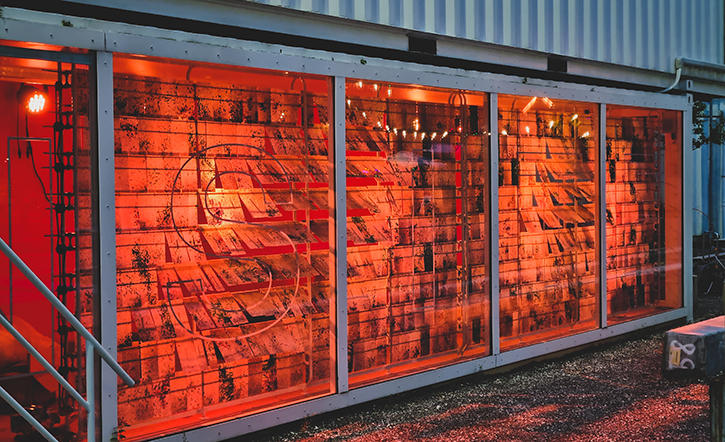Experience the PERFORMING PLASTIC SURGERY exhibition in ONSITE GALLERY from October 4th to the 31th of December.
PERFORMING PLASTIC SURGERY is made by:
Chris Thurlbourne, Associate Professor, Aarhus School of Architecture
Mads Hulsrøj Jæger, Architect, Research Assistant, Aarhus School of Architecture

There is endless disused plastic waste scattered across the globe. A tsunami of unwanted plastic that disperses, to make way for more injection molded addiction. The old pieces – consigned to the rubbish tip. And so it goes on. Since the 1960s the global production of plastics has increased twenty-fold to 368 Million tons in 2019 (Plastics Europe, 2020), and production is expected to double in the next 20 years (EU Commission, 2018).
Yet it is a keystone of our developed world, where we rely on this ductile material to support our society and its development. In architecture too, we rely on polymers. But instead of celebrating this omnipresent material, we hate it. It adsorbs precious natural resources. Denmark is currently using 750.000 tons of raw material annually for plastics alone. More significantly, when there is no further use of those plastic artefacts littering our lives, we simply don’t know what to do with it. That’s 440.000 tons of annual plastic waste (Pivnenko et.al., 2019) and we don’t know what to do with. The material seems to have little value to our lives.
Plastic is soulless. Plastic is devoid of character. It’s artificial. Too complete. Too throwaway. Plastic is rubbish. Plastic is resource demanding.
But is it?
1m3 of recycled concrete uses over nearly 30 times more energy to demolish, transport and crush to return to industry as aggregate, than plastic recycling uses. Global concrete use in buildings generates enough CO2 every 2 years than plastic industry has emitted in total from its invention at the turn of the last century. Recycling plastic can generate a reduction potential of 0.5 million tons CO2 (direct emissions) (Regeringens klimapartnerskab, 2020). To reform plastic, you can use a domestic oven. Our recipes are 30 mins at 190-220 degrees in a fan assisted oven. It’s just like baking bread.
At the Aarhus School of Architecture we have tried to address this paradox and research how to give embedded value of plastic as a desirable material through the research project Searching for Imperfection. We thought, as architects embedded in a creative field of research through design, surely this waste could be recovered and brought to good use. And could eventually promote beautiful architecture.
- We have explored the inherent qualities of this plastic.
- We have invented a tectonic of how to manufacture what could be evident in a final building component.
- We have built a sun shield, or curtain, that is dynamic to reveal the different levels of transparency as the curtain – or rather shingles – rotate.
- We have demonstrated that this ugly, throwaway, despised material can actually be rather elegant, and maybe an object of desire.
- We have pushed the material so that it doesn’t adopt the usual mass-produced appearance, but reveals the act of making
- We have performed plastic surgery and we like the new look
- We hope to have demonstrated the resulting building component expresses a degree of elegancy by allowing the shingles to move at a slow pace one can be hypnotized by the moves
 Foto: Jon Engholt
Foto: Jon Engholt  Modes of Tectonic Thinking Ph.d.-forsvar: Modes of Tectonic Thinking
Modes of Tectonic Thinking Ph.d.-forsvar: Modes of Tectonic Thinking  Foto: Jon Engholt
Foto: Jon Engholt  Modes of Tectonic Thinking Ph.d.-forsvar: Modes of Tectonic Thinking
Modes of Tectonic Thinking Ph.d.-forsvar: Modes of Tectonic Thinking